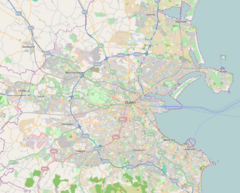
A | B | C | D | E | F | G | H | CH | I | J | K | L | M | N | O | P | Q | R | S | T | U | V | W | X | Y | Z | 0 | 1 | 2 | 3 | 4 | 5 | 6 | 7 | 8 | 9
 View of the platforms and bridge | |||||
| General information | |||||
| Location | Taney Drive Dundrum, County Dublin Ireland | ||||
| Coordinates | 53°17′32″N 6°14′42″W / 53.29234°N 6.24506°W | ||||
| Owned by | Transport Infrastructure Ireland | ||||
| Operated by | Transdev (as Luas) | ||||
| Line(s) | Green | ||||
| Platforms | 2 | ||||
| Bus routes | 14, 44, 44B, 44D, 74, 161, 750, L25, S6 | ||||
| Bus operators | Dublin Bus, Dublin Coach, Go-Ahead Ireland | ||||
| Construction | |||||
| Structure type | Elevated | ||||
| Accessible | Yes | ||||
| Other information | |||||
| Fare zone | Green 2/3 | ||||
| Key dates | |||||
| 10 July 1854 | Station opened | ||||
| 31 December 1958 | Station closed | ||||
| 30 June 2004 | Luas stop opened | ||||
| 2018 | Platforms extended | ||||
| |||||
Dundrum (Irish: Dún Droma) is a stop on the Luas light rail tram system in Dublin, Ireland which serves the suburb of Dundrum. It opened in 2004[1] as a stop on the Green Line, which re-uses the alignment of the Harcourt Street railway line which closed in 1958. Dundrum Luas stop is built on the same site as a former heavy rail station of the same name.
History
Railway station (1854–1958)

Harcourt Street Line | ||||||||||||||||||||||||||||||||||||||||||||||||||||||||||||||||||||||||||||||||||||||||||||||||||||||||||||||||||||||||||||||||||||||||||||||||||||||||||||||||||||||||||||||
|---|---|---|---|---|---|---|---|---|---|---|---|---|---|---|---|---|---|---|---|---|---|---|---|---|---|---|---|---|---|---|---|---|---|---|---|---|---|---|---|---|---|---|---|---|---|---|---|---|---|---|---|---|---|---|---|---|---|---|---|---|---|---|---|---|---|---|---|---|---|---|---|---|---|---|---|---|---|---|---|---|---|---|---|---|---|---|---|---|---|---|---|---|---|---|---|---|---|---|---|---|---|---|---|---|---|---|---|---|---|---|---|---|---|---|---|---|---|---|---|---|---|---|---|---|---|---|---|---|---|---|---|---|---|---|---|---|---|---|---|---|---|---|---|---|---|---|---|---|---|---|---|---|---|---|---|---|---|---|---|---|---|---|---|---|---|---|---|---|---|---|---|---|---|---|
| ||||||||||||||||||||||||||||||||||||||||||||||||||||||||||||||||||||||||||||||||||||||||||||||||||||||||||||||||||||||||||||||||||||||||||||||||||||||||||||||||||||||||||||||
The Harcourt Street railway line was built by the Dublin, Wicklow and Wexford Railway and opened in 1854, running from a temporary terminus at Harcourt Road near the city centre to Bray. Dundrum was one of the four original intermediate stops along with Stillorgan, Carrickmines and Shankill. The station was located at the side of Taney Road, which the line crossed on a bridge.
Dundrum was more elaborate than other stations on the Harcourt Street line and was subsequently the most popular station on the line. The station was designed by William Dargan, who lived in the area and regularly used the station. It had buildings on both platforms: the up (Dublin-bound) platform featured waiting rooms and a signal box.[2] The down platform was the location of the station master's house.[3] and the main station building with the ticket hall.[4] This building had one storey, and its entrance from the platform was via a small portico with the roof suspended by a colonnade. This area could be used as a passenger waiting shelter.[5] The platforms were linked by both an iron footbridge and a granite subway.[6]
A short siding was located to the south of the station, allowing goods trains to terminate.[7]

For many years, Dundrum was served as the destination for boarding students attending St Columba's College in Rathfarnham over two miles away. For this reason the signal cabin on the northbound platform carried a large sign reading Station for St Columba's College, which was almost as large as the station name board.
Closure (1959–2004)
The Harcourt Street line had declined in use throughout the early 20th century and was becoming rundown in the 1940s and 50s. Dundrum was the last station on the line to serve goods, up until the 1950s. While Dundrum was still more busy than the other stations, it wasn't receiving enough income to justify the line's existence and the Harcourt Street line was closed by CIÉ at the end of 1958, much to objection from the community. The tracks were lifted soon after and all stations on the route were auctioned off. The waiting rooms, signal cabin, and house at Dundrum were demolished in the years that followed. The station building survived, but fell into disuse. The nearby bridge over the road was removed following the track removal and became the catalyst for the Dundrum flood of 1963 when heavy rainfall caused the banks of the former station to burst and flood across the village. The beams and embankment were demolished in 1971 during the construction of the junction for Churchtown, Dundrum and Taney roads.[8]

